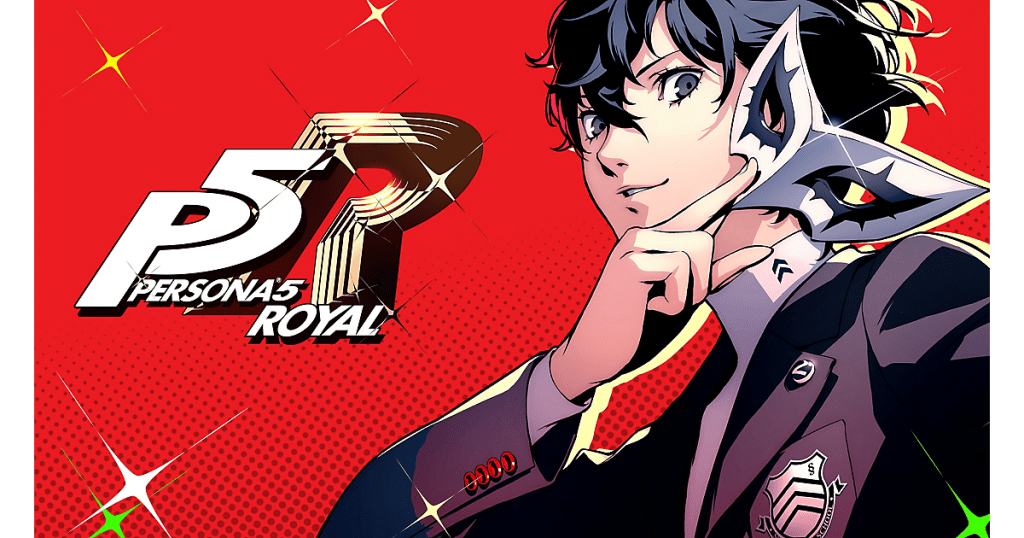
Atlus’ Persona 5 released on Playstation 3 and 4 in 2016 to widespread acclaim. Fans of the J-RPG genre loved the lengthy story, in-depth character relationships and action-stealth exploration and critics were into it too. Persona 5 Royal is an upgraded, even more content-rich edition of the original title. There is a lot to explain, and I hope to make this review accessible for those like myself who do not have a degree in Shin Megami Tensei lore. Persona 5 Royal can be purchased digitally for £49.99.
In Persona 5 Royal you play as *name of your choice* (we’ll call him Phil from now on), a nerdy looking fellow who got chucked in the sin bin for using his fists to stop a powerful man from carrying out a rape. Phil is a good lad, but has been forced to transfer across the country to a new school to keep out of trouble, Fresh Prince-style. When he arrives at the Tokyo coffee shop which is to become his home his criminal record is the talk of town, and to make matters worse he soon becomes a target of pervy P.E teacher Suguro Kamoshida. Kamoshida is beating up pupils left, right and centre, and is even using his power and influence to pressurise girls into doing his bidding. Worse still, the parents and the teachers don’t want to challenge him because he is a former Olympic athlete and leads a star volleyball team.
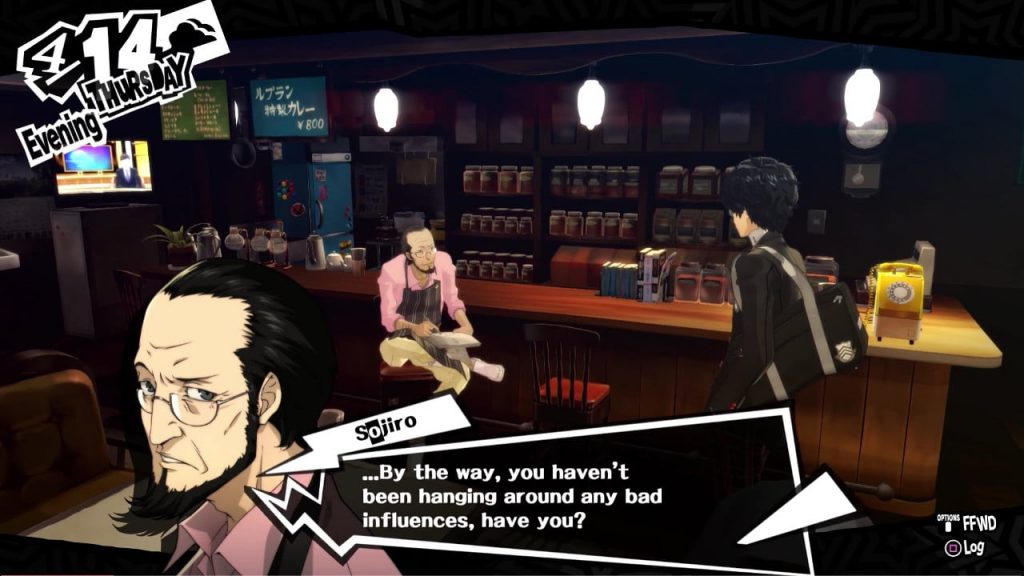
The meek, unassuming Phil accidentally becomes the leader of a plot to take down Kamoshida through magical means. It isn’t long before Phil is awakened as Joker, a fairly awesome magical superhero with a mile-wide grin and sweet black duds.
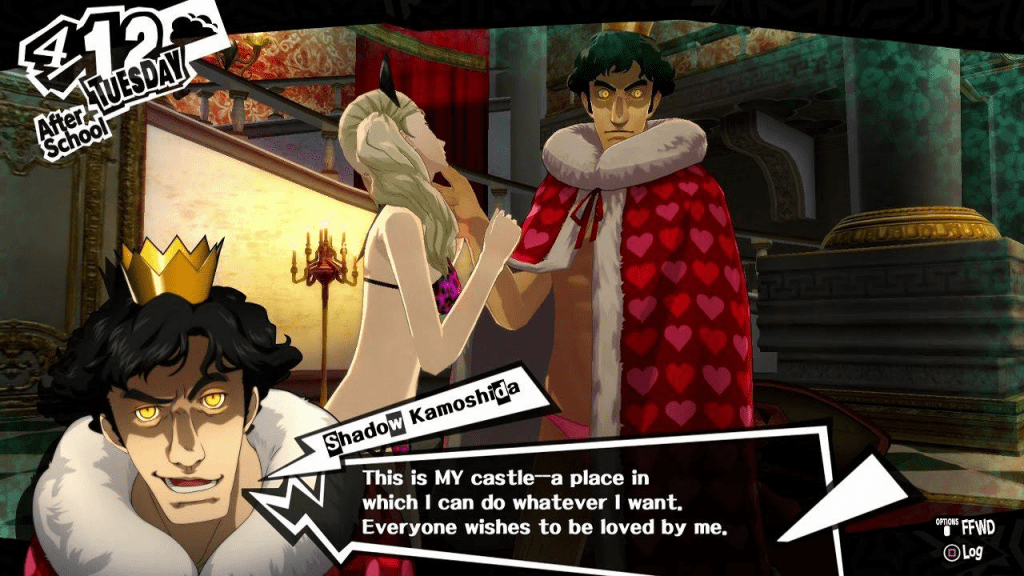
Yes, the story is kind of weird. In the world of Persona 5 Royal particularly bad eggs unknowingly create twisted hideouts in the metaverse called “palaces”. Each of these buildings mirrors a location in the real world, but is distorted according to their peculiar peccadilloes. Kamoshida sees himself as the king of the school in which he teaches. This is reflected in the form he takes in the shadow dimension, and also in his palace, which is an imposing castle replete with dungeons, libraries and red carpet all over the shop. It falls to Joker and his newly acquired pals, Ann, Morgana the cat-person and Ryuji to travel into the metaphysical realm and get medieval on his lycra-shorted arse, wrecking his fantasy palace in the process.
Destroying a palace affects its owner in the real world, essentially having the potential to purify their heart and compel them to atone for their sins. There are other evil-doers besides Kamoshida, just waiting for a supernatural soul-pasting. Joker and his gang, the Phantom Thieves, see taking down these nasty numpties as a means of furthering their reputation, in turn encouraging others to come forwards to inform them of other wrong-doers via their “phan-site”.
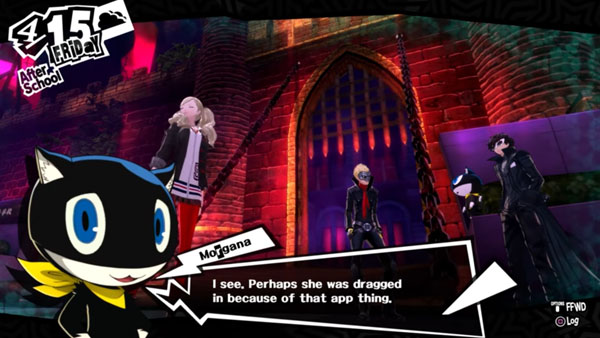
In addition to more physical attacks, Joker has the ability to control personas to help him carry out his metaphysical maulings. Personas are a bit like mythical beast versions of Pokemon. Each has a different sets of magical attacks at their disposal and they can be upgraded to gain new skills just like their cuddlier Nintendo counterparts. Ann, Morgan and Ryuji each have their own Personas too, although Joker is special due to his ability to carry around a multiple monster menagerie.
It’s not all magical arse-kicking in goth gear though. Phil and his (human) friends must also become attend school and become something resembling fully functional people by learning, forging relationships and just, you know, hanging out.
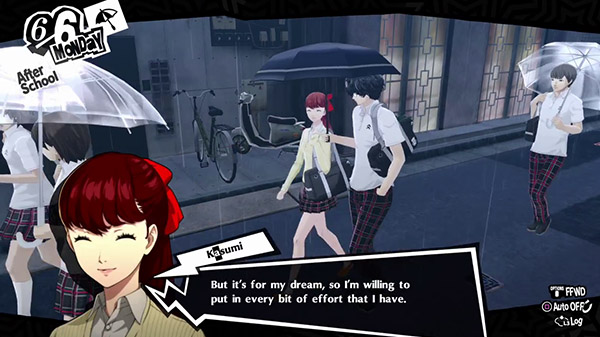
If this all sounds a bit convoluted it’s because it is. At least at first. Persona 5 Royal is unapologetically tropey and feels tailored to a Japanese anime/J-RPG audience, which might make it initially difficult to access for new-comers. There’s no doubt that someone steeped in the genre will feel at home pretty quickly. If this isn’t you don’t navigate away just yet, because even if you’re not a J-RPG stalwart there is much to love.
Gameplay
There are no two ways about it. Persona 5 Royal is slow to get going. The first 10-20 hours are VERY guided and dialogue-heavy, and while mostly quite amusing, not all of the dialogue is great. Just when it feels like you are getting cracking a new mechanic is introduced which prompts an extended cutscene. To make matters worse, the explanations of key mechanics are often quite slight, making deciphering what to do and when a challenge.

In all honestly, I wasn’t having a great time to start with. Much of the day-to-day activities take place in the school, and I found the restrictive calendar frustrating. Each lesson offers the-schoolboy-also-known-as-Joker the opportunity to improve his social statistics by answering a question, but these are massively weighted towards a Japanese audience. Either brush up on far Eastern warlords and artists or play with your phone at your side. When school is over you usually have two time-slots in which to engage in activities which allow further opportunities to boost your personal attributes, but sometimes you will be forced into an activity or made to go to bed early. Sometimes you might be allowed to explore the city, whereas other times you might be confined to the coffee shop. The unpredictable, anime-esque nature of the first hours of the game might be exciting to some, but I just wanted to get slapping.
Thankfully eventually the training wheels come off, leaving only the unnecessarily lengthy conversations as an occasional frustration. Exploring palaces is pretty fun. It’s massively beneficial to take a stealthy approach and, if you decide to take on an enemy, attack first. Thankfully Joker is extremely agile, and can vault from one hiding place to another with ease. There is loot everywhere, and much of this can be sold in the real world to enable you to buy improved gear and weaponry, along with the usual lotions and potions.
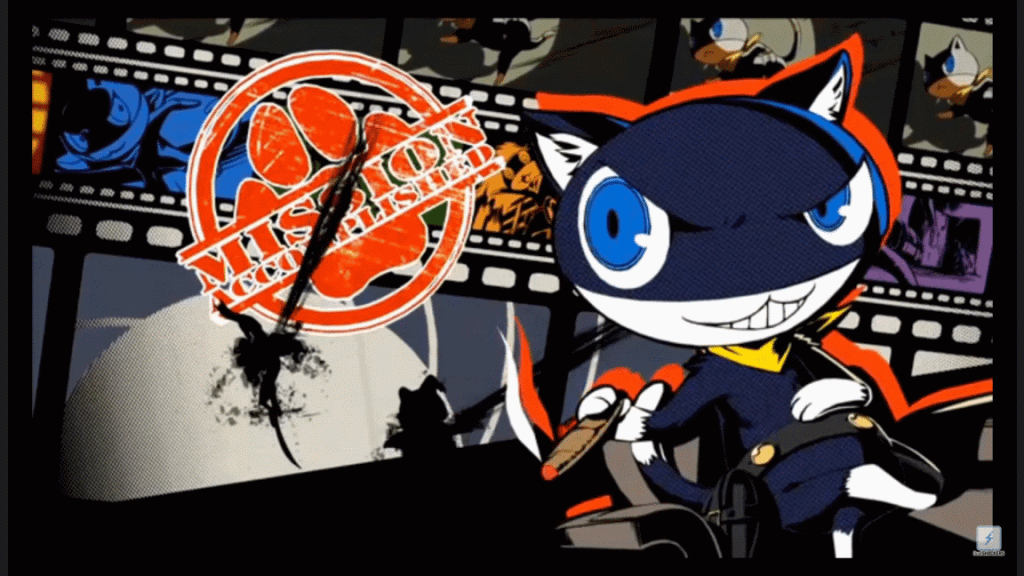
The calendar mechanic isn’t well-explained. Once a palace becomes available you are given a number of days in which to defeat the owner before disaster strikes. The reason for the count-down is different for each palace. You must crumble Kamashida’s castle quickly as he plans to suggest to the school board that you and your friends be expelled. You are pressurised to tackle the palace by your friends each day, but it also feels like you should be using the time you have to level up and earn money to buy improved equipment, especially as the game’s loading screen seemingly encourages you to “Take your time”. Persona 5 Royal neglects to tell you two things. Namely that a palace cannot be finished on the last day you have available, and also that you still get the time you would have to improve if you finish the palace early. Leave it too late to tackle a palace and you’ll get a grim game over sequence and the option to return to your last save or go back in time seven days. Don’t muck about.
Combat when it happens is pretty easy, providing you strike first. Battles are turn-based. Each character in your party has a melee weapon, a gun and their Persona/spells. Taking down a group of enemies is typically as simple as using the attacks or spells they are weak to. Hitting an enemy in their Achilles heel “downs” them, taking them out of the action temporarily. Attacking an enemy’s weakness also allows you a “1 More”, enabling you to attack another enemy’s weakness.. and so on.
You can even let the battles play themselves to an extent. Giving each of your team free reign to attack of their own volition will often lead to the enemy being wiped out before you can even launch an attack.
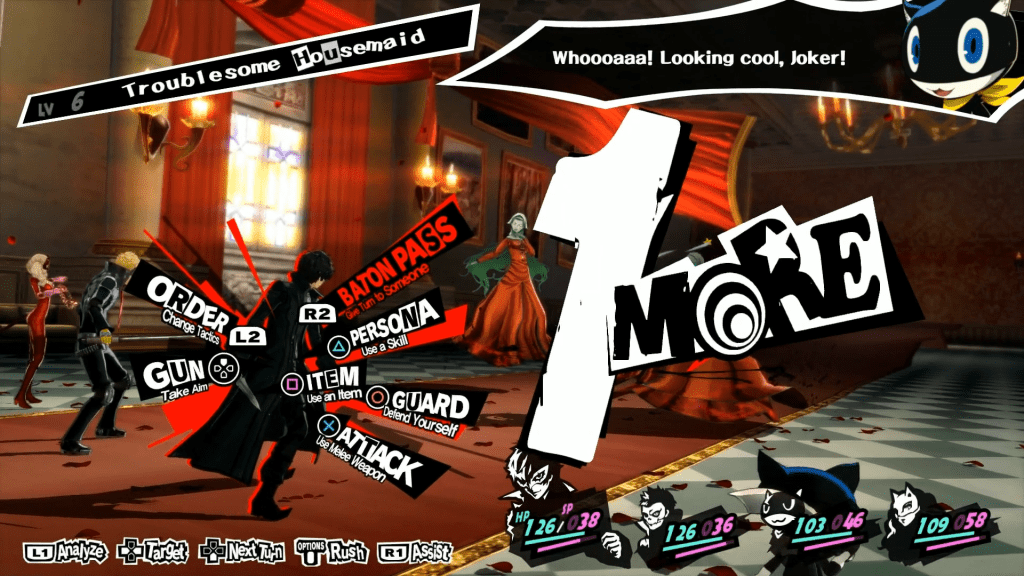
Early on the odds feel heavily stacked against the baddies, who shunt around dozily in the palaces, waiting to be jumped. In many battles I wasn’t attacked once. If an enemy gets the jump on you the tables are flipped, however. They can quickly attack your weaknesses and whittle down your health, forcing you to spend precious items or magic healing your party. As the game progresses and the palaces become deadlier it becomes harder to approach an enemy with stealth and the enemies weaknesses aren’t as immediately obvious.
If you manage to down all your enemies you have the option to ask something of one of the enemies you have defeated. You can request that it join your persona collection, give you money or provide you with an item. There is also the option to carry out an all-out attack involving all of your team, which will often wipe out the remaining resistance and give you more XP. If you choose the peaceable route and the enemy is your level or lower, you will be asked a series of questions. These must be answered correctly depending upon the personality of the Persona, and if you are successful you will receive what you asked for. Sometimes you might need to be threatening, conciliatory or even flirtatious.
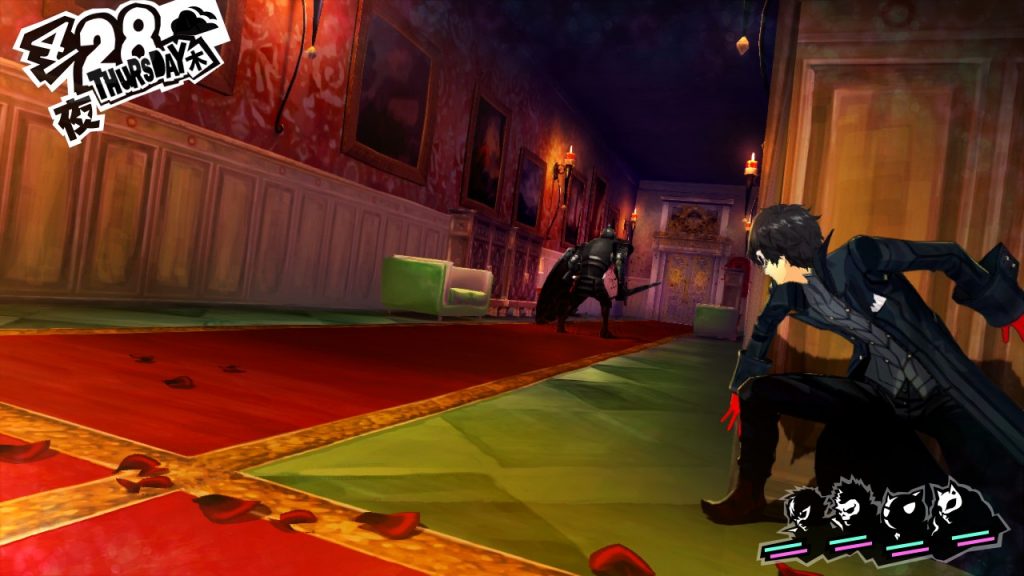
It’s difficult to complete a palace in one go. Each character has an SP meter, which will run down as they use their spells. Most enemy’s weakness is magical, meaning if your meter is drained you’re often in for a slog. You can buy items to replenish your meter, but sometimes it might just be better to slink away and return another day. Thankfully each palace has several safe rooms, which allow you to save and fast travel. This means you can go away and recover your SP by sleeping then return in full force in a later part of the palace. The safe rooms also nicely break up the gameplay, allowing you to stock up, work a job, hit the batting cages or take in a movie.
You can also build up your relationships, which is one of the stronger aspects of Persona 5 Royal. Certain NPCs in the game are known as “Confidants”. These are people with whom Joker can forge a mystical bond. Each confidant is themed around a tarot card. Using your free time to hang out with these folks usually results in levelling up your relationship Doing so can confer passive benefits, such as XP boosts or the ability to craft beneficial new items. It’s a nice system which rewards you for getting to know the characters which populate Persona 5 Royal‘s version of Tokyo.
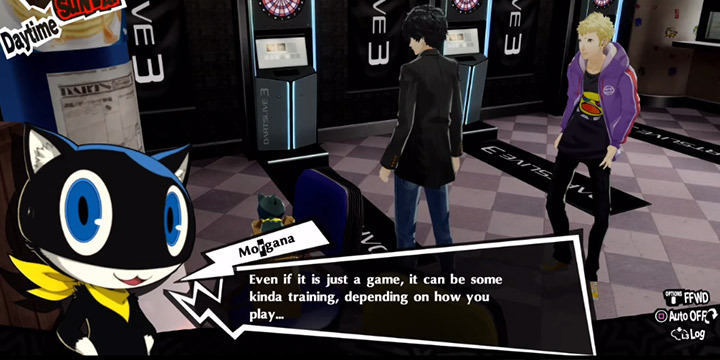
These relationships play into the persona fusion mechanic. To begin with, Joker can execute two personas, leading to the creation of a new one. Each persona also has a tarot card associated with it, and if the generated persona matches the tarot card of someone with whom you have developed a relationship it will immediately gain a massive experience boost, improving your skills in battle.
Conversations can be set to auto-play or progress with at the player’s pace, and at times you can almost watch the story unfold as you would an anime, with only the odd multiple choice question breaking up the flow. I actually started to find this quite relaxing and a nice foil for the less story-heavy sequences.
Graphics
Persona 5 Royal is one of the most stylish games I have ever laid eyes on. The presentation, from the brilliantly-animated cutscenes to the red and black noir-ish comic book panels and menus, is fantastic. The in-game graphics are a more muted cel-shaded affair but they work really well. Character design is generally strong, although I could do without the tropey and slightly creepy cat character.
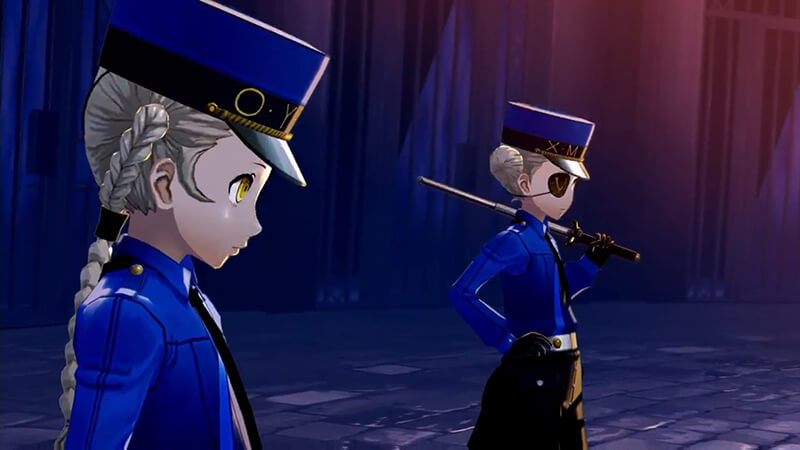
Audio
Music in Persona 5 Royal is another strong suit, with glistening J-pop giving way to melodic heavy rock. The music fits the Tokyo aesthetic perfectly. The tune that follows winning a battle is almost a reward for challenging enemies in itself.
Voice-acting is generally pretty decent, and is no worse than what you would see in a dub of major Japanese anime. Some of the dialogue is pretty weird, and is delivered in a weird way too. I cringed every time the pervy cat lad said “You’re so gorgeous, Panther!” each time my female sister-in-arms wiped out an enemy in battle. Ditto when my sort-of-adoptive dad Sojiro said that he didn’t want my phone number as he made it a habit not to save guys’ numbers in his phone. Er…

Longevity
Persona 5 was a huge game when it originally came out, offering a 100 hour+ campaign. Persona 5 Royal introduces even more content. There’s actually too much to list here… new story segments, characters, cutscenes, areas in the hub world, personas… even a grappling hook. You can also unlock content in the “Thieves Den”, a sandboxy environment where you can muck around making dioramas using character models and so on. Not all of the additions are great. Procedurally-generated dungeon Mementos was, according to some, a bit of a damp squib in the original title, and it’s been expanded in Persona 5 Royal for more damp squibbiness.
That feels like nitpicking though. It’s really nice to see the effort Atlus have put into what could have been a far less generous package.
Persona 5 Royal is the product of a lot of love, care and hard work. I’m not ashamed to say in spite of the many hours I’ve put in I’ve barely scratched the surface of everything on offer.

Conclusion
Persona 5 Royal is a great version of a great game which rewards your patience with loads of story, laughs and gameplay depth.
I give it the Thumb Culture Gold Award.

Disclaimer: A code was received in order to write this review.
This article was written by Philip Brook

YouTube | FaceBook | Twitter | Instagram| Twitch
Spotify | iTunes | Google Play Music | Stitcher
